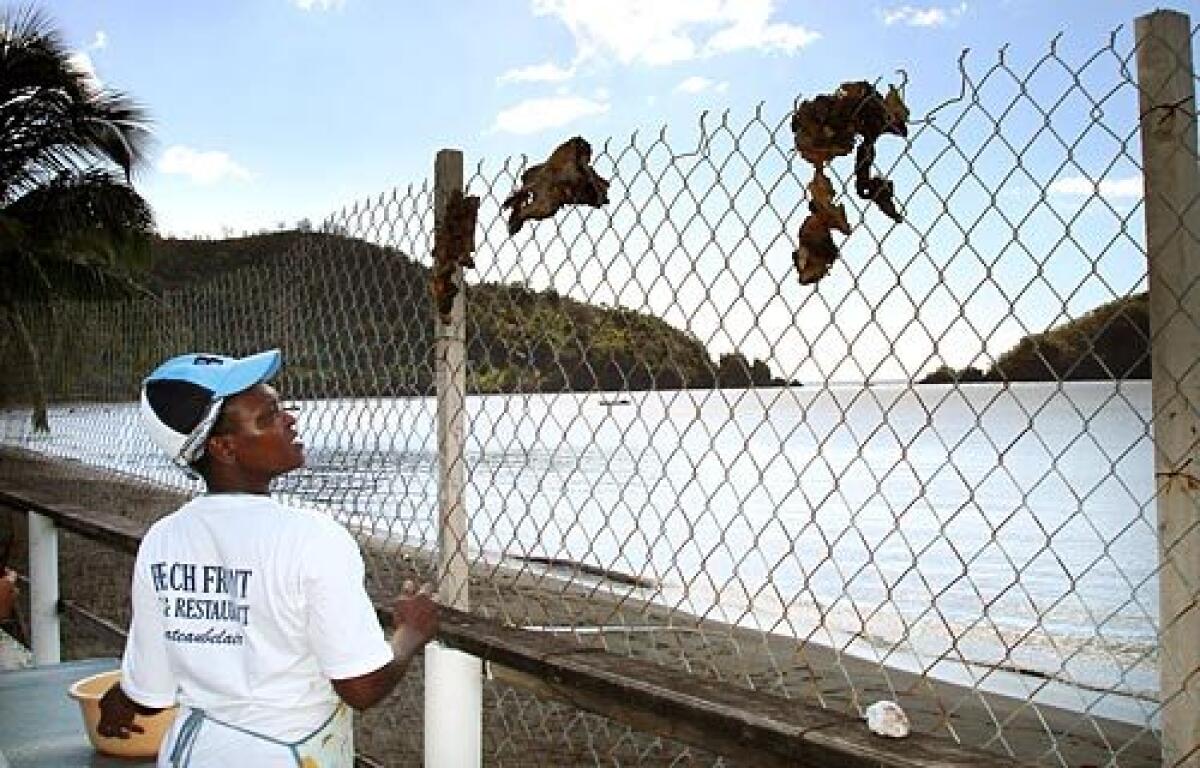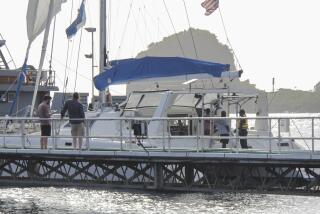Yachts encountering real pirates of the Caribbean

When two men wielding cutlasses and a third brandishing a gun burst onto their yacht at 1:30 in the morning, Allison Botros and the seven others aboard suddenly realized that “Pirates of the Caribbean” is not just a movie.
“Give us your money or we will kill you,” Botros recalled the robbers telling them during the 15-minute ordeal. The mother of three from Cleveland was cruising with Swedish and American friends aboard the 70-foot Sway, which was boarded as it was anchored in this pristine harbor that is shadowed by the La Soufriere volcano and rimmed by swaying palms.
FOR THE RECORD:
Pirates: A photo in Section A of Sunday’s print edition accompanying an article about pirate attacks on yachters in the Caribbean was of St. Vincent’s Cumberland harbor, not nearby Chateaubelair harbor. —
After shaking down the passengers for thousands of dollars in cash, watches, cameras and cellphones, the robbers ordered skipper Harald Krecker to motor out to sea or be hit with rocket-propelled grenades.
More than five months after the Dec. 22 incident, the robbery victims have yet to receive a police report, the pirates remain at large, and the sleek yachts that ply the teal waters of the Windward Islands have gone elsewhere, making a ghost town of scenic Chateaubelair.
Attacks on yachters across the Caribbean have marred the luxurious cruising life with increasing frequency as the number of vessels sailing the lush islands grows year to year, and with it the lure of valuables for thieves and drug traffickers in the region.
At least three other attacks were reported in Chateaubelair in a two-week period in December, all involving three men, two long knives and a handgun.
“What is new in the last two to three years is an increase in the use of weapons,” said Melodye Pompa, administrator of the Caribbean Safety and Security Net website, a sailing community endeavor that logs thefts, robberies and assaults committed against boaters. “It’s becoming more violent. I’ve tracked that across the region we cover.”
Most of the hundreds of incidents collected from 30 countries and territories over the last four years involve dinghy and outboard motor thefts or burglaries of boats while passengers were ashore. But guns and knives are being used more frequently, and dozens of incidents involving beatings and stabbings are among the crimes reported to the website, which compiles its statistics from charter operators, marinas, harbor masters and the victims.
No one on board the Sway was hurt, but the captain of another yacht, the Chiquita, which was attacked here the next night, suffered multiple cuts, including two head wounds that required stitches at a hospital in Kingstown, the island nation’s capital.
“There are times when it’s happening and you think it’s not real,” Botros said. “At one point one of them said, ‘If you don’t find your wallet, I’ll kill you,’ and I was so traumatized I forgot that I hadn’t brought my wallet on the trip. I was saying, ‘Oh my God, I can’t find it! I’ve got to find it!’ thinking about our kids at home.”
Yachting visitors and the local suppliers who cater to them are the mainstays of many Caribbean island economies, including St. Vincent’s. A week’s charter of a luxury sailing vessel such as the Sway costs more than $13,000 plus expenses, and mega-yachts, with their onboard swimming pools and helicopters, are increasingly dropping anchor and treasure at the beautiful harbors of the region.
The December crime wave prompted some added vigilance by the coast guard and police, but specifics of the response were unclear. Representatives of the St. Vincent police did not return calls or answer e-mails after receiving a request for an interview on what they were doing to combat crime against yachters.
The attacks also galvanized the island’s sailing businesses. Fearing for their livelihoods, yacht charterers and provisioners anted up funds for a patrol boat and published a list of do’s and don’ts for prospective cruisers. Some said that only put the dangers in black and white.
“If I got this, I would get on the next plane out of here and go home,” Mary Barnard, managing director of Barefoot Yacht Charters, said of the brochure, which essentially advises sailors to stay locked up, on board and under guard at all times.
She produced a letter from a Canadian couple who had been customers for years, in which they said that their June 2006 assault and robbery by men armed with machetes had compelled them “to stop all cruising in your area.”
At the Beach Front Restaurant & Bar on Chateaubelair harbor, waiter Felix Granderson said he thought it might be safer these days because of stepped-up security but that it was difficult to tell because sailors no longer anchored here. He said the pirates were holed up in the towering mountains above the harbor.
“Everybody knows who’s doing it. It’s guys who don’t want to work, from Fitz-Hughes,” he said, referring to a remote village on the flanks of La Soufriere.
Even if arrests are made in such crimes, the victims are seldom able to return to identify or testify against their attackers, said Chris Doyle, author of popular cruising guides for the Caribbean.
“The islands have a judicial system that dates back a bit and is very much in favor of the criminal when the victim does not stay around,” he said, explaining why the yacht pillagers are seldom prosecuted.
Police in the islands tend to be in “react mode,” Pompa said of the short-lived flurries of concern and investigation that follow incidents. But some islands have taken lessons from the bad publicity that cuts into the tourism industry, on which most of them are dependent.
“Dominica, up until about eight years ago, had a terrible reputation, and it was deserved,” she said of the island about 135 miles north of here where pirates preyed on visiting vessels. When sailors stopped anchoring there, the prime minister got the business community together to bankroll a patrol boat that has drastically reduced onboard crimes, she said.
Pirates who attacked a yacht in Rodney Bay in St. Lucia -- about 60 miles north of here -- two years ago severely beat the captain and raped his wife, causing the number of visits to drop by half, Pompa said she was told by local officials. The government deployed a port patrol boat, which “seems to be somewhat of a deterrent,” Pompa said.
Crimes against boaters are down throughout St. Lucia this year, she said, and no recent incident has involved violence, according to web logs at safetyandsecuritynet.com.
Others with long experience sailing the Caribbean contend that it isn’t so much that crime has increased, but rather the volume of cruising traffic and the means of communicating the incidents.
“There’s definitely a concern, but it’s really hard to say if there is more crime against yachts than there ever was or if dissemination of the information is just better now,” said Sally Erdle, editor of the Caribbean Compass, a monthly newspaper published in Bequia, another island of St. Vincent and the Grenadines that is popular with the sailing crowd. “With the Internet, the yachts all e-mail reports of these incidents far and wide immediately, and also discuss them on yacht and ham radio nets.”
The seaboard jungle drums can also generate multiple reports of a single incident, she noted, “turning it into a dozen in the minds of the public.”
“Bad things come in waves,” said author Doyle, whose cruisingguides.com includes advisories about crime waves in places of real concern such as Venezuelan islands and Chateaubelair.
“If we have a trouble spot with those responsible still loose, we need to try to warn people,” he said. “The problem then becomes, how much does the warning generalize? For example, we have had a problem in Chateaubelair, but not Cumberland or Wallilabou, a few miles to the south. How do we stop people becoming so paranoid they avoid the whole west coast?”
Disturbing as the robberies and other occasional violent incidents are, they remain exceptions, he said, recalling six incidents during the last season out of 1,000 moorings by charters in St. Lucia’s Soufriere Marine Management Area.
“The police in the islands do make an effort, especially in response to really bad and well-publicized events, such as rape,” he said. But most of the crimes cast as piracy against yachters “are no more than the occasional stolen dinghy and break-in.”
More to Read
Start your day right
Sign up for Essential California for news, features and recommendations from the L.A. Times and beyond in your inbox six days a week.
You may occasionally receive promotional content from the Los Angeles Times.







